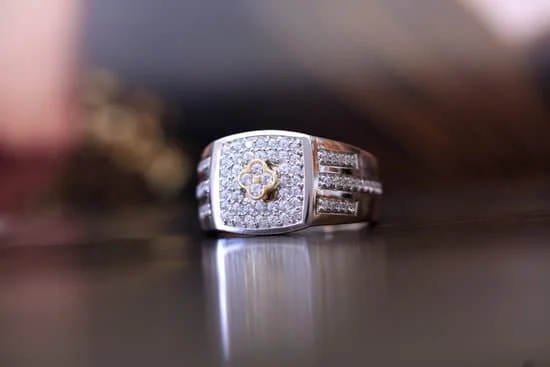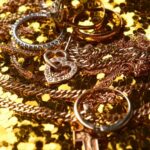Diamond jewelry is not only a symbol of luxury and beauty but also a significant investment. However, understanding how diamond jewelry is valued can be a complex process. In this article, we will delve into the intricacies of diamond valuation, uncovering the factors that determine the worth of these precious gemstones.
The value of diamond jewelry holds great importance in the market, both for buyers and sellers. For buyers, knowing the value ensures that they are making an informed decision and getting what they pay for. On the other hand, sellers need to accurately determine the value to ensure a fair price for their diamond pieces. But how exactly is this value determined?
Jewelry buyers and sellers rely on various factors known as the 4Cs to assess the value of diamond pieces. These four crucial factors are cut, clarity, color, and carat weight. By analyzing and evaluating each of these elements, experts can assign a monetary worth to diamond jewelry. In the following sections, we will unravel these foundational factors in more detail to understand their impact on diamond valuation.
The 4Cs
When it comes to valuing diamond jewelry, there is a foundational set of criteria known as the 4Cs that plays a crucial role. These four factors, including cut, clarity, color, and carat weight, are used by both jewelry buyers and sellers to determine the overall worth of a diamond piece.
Firstly, the cut of a diamond refers to how well it has been shaped and faceted. The cut grade evaluates the craftsmanship and artistry involved in creating the final shape and arrangement of facets. The quality of a diamond’s cut significantly impacts its appearance, brilliance, and sparkle. Various diamond cuts exist, each with its own characteristics and style.
The most popular cut is the round brilliant cut due to its ability to showcase maximum fire and brilliance. Other common cuts include princess, emerald, marquise, pear, oval, heart, and radiant. When assessing the cut grade of a diamond, experts consider factors such as symmetry (how well-aligned facets are), proportion (ratio between different parts of the stone), and polish (the smoothness and finish).
Clarity is another important factor in determining the value of diamond jewelry. It refers to the presence or absence of imperfections within the stone called inclusions or external flaws called blemishes. These imperfections are usually natural occurrences during the formation process but can impact a diamond’s visual appeal and brilliance.
Clarity grading systems provided by reputable organizations like GIA (Gemological Institute of America) or AGS (American Gem Society) help assess these imperfections on a scale ranging from Flawless (no imperfections visible under 10x magnification) to Included (imperfections visible to the naked eye). The fewer inclusions or blemishes a diamond has at higher levels of magnification, the higher its clarity grade will be.
Color also plays an essential role in the valuation of diamond jewelry. While many people think of diamonds as colorless, they can actually exhibit a wide range of hues ranging from colorless to yellow or brown, depending on their composition. The Gemological Institute of America introduced a color grading scale (D-Z) that assesses a diamond’s hue and assigns it a corresponding letter grade.
Colorless diamonds at the top end of the scale (D-F) are rare and highly valued due to their exceptional whiteness and lack of visible tint. As the scale progresses towards Z, diamonds become more yellow or brown in hue, decreasing their value.
Overall, understanding the 4Cs is crucial when it comes to valuing diamond jewelry. The combination of these factors plays a significant role in determining a diamond’s worth in the market.
A stone with an excellent cut grade, high clarity with minimal imperfections, and colorless appearance will generally fetch a higher price than one with subpar ratings in any of these areas. By considering each C individually and how they contribute to the overall value, buyers and sellers can make informed decisions when trading diamond jewelry.
The Aesthetics Factor
The cut grade of a diamond is one of the most important factors in determining its value. The cut refers to how well a diamond has been shaped and faceted, which directly affects its brilliance and overall appearance. There are various diamond cuts, with the round brilliant cut being the most popular and sought-after due to its ability to reflect light exceptionally well. Other popular cuts include princess, emerald, marquise, and pear.
The Impact of Cut on Diamond Value
The cut grade of a diamond is assessed based on several factors, including symmetry, proportion, and polish. Symmetry refers to how well the facets of a diamond align with each other, while proportion determines how well the different parts of the diamond relate to each other in terms of size and shape. Lastly, polish assesses the smoothness and quality of the diamond’s surface.
A higher cut grade indicates that a diamond has excellent symmetry, precise proportions, and impeccable polish. This enhances its ability to reflect light back to the viewer’s eye, resulting in superior sparkle and brilliance. Diamonds with lower cut grades may appear dull or lackluster because they do not maximize their light performance.
Understanding Cut Grades
The Gemological Institute of America (GIA) rates diamonds’ cut grades based on a scale ranging from Excellent to Poor. An Excellent-cut diamond reflects nearly all incoming light as brilliance. Very Good-cut diamonds offer exceptional brilliance but may have slight imperfections in symmetry or proportions. Good-cut diamonds still exhibit good overall beauty but may sacrifice some brilliance.
Fair – or Poor-cut diamonds do not reflect light as effectively as those with higher cut grades and may appear dull or lifeless. It’s important for prospective buyers to understand that poorly cut diamonds can negatively impact both their appearance and value.
When evaluating the aesthetics of a diamond’s cut grade, it is crucial to consider the individual preferences and tastes of potential buyers. Some may prioritize maximum brilliance and sparkle, while others may prefer a different balance of factors such as fire or scintillation.
Unveiling the Clarity
The clarity of a diamond plays a vital role in its valuation. It refers to the presence or absence of imperfections within the stone, known as inclusions and blemishes. Inclusions are internal flaws such as tiny crystals, while blemishes are external flaws like scratches or chips on the surface of the diamond. Evaluating the clarity of a diamond involves examining these imperfections and determining their impact on the overall value.
Detailed examination of common clarity characteristics
When assessing the clarity of a diamond, gemologists look for various characteristics that can affect its value. Inclusions can range from pinpoint-sized specks to larger fractures or clouds. Blemishes may include scratches, nicks, or abrasions on the surface. The size, number, type, position, visibility, and color of these imperfections all contribute to determining the clarity grade of a diamond.
For instance, diamonds with fewer or less visible inclusions and blemishes are considered higher in clarity and therefore more valuable. Conversely, diamonds with numerous or prominent imperfections may receive lower clarity grades and have decreased worth.
Overview of diamond clarity grading systems
To standardize and provide consistency in evaluating diamond clarity, reputable organizations like the Gemological Institute of America (GIA) and American Gem Society (AGS) have established grading systems. These systems assign specific grades to diamonds based on their level of imperfections.
GIA’s grading scale consists of six categories: Flawless (FL), Internally Flawless (IF), Very Very Slightly Included (VVS1,VVS2), Very Slightly Included (VS1, VS2), Slightly Included (SI1, SI2), and Included (I1,I2,I3). On the other hand, AGS follows a more detailed ten-grade scale from 0 to 10.
These grading systems assist buyers and sellers in accurately understanding the clarity of a diamond and its effect on value. When purchasing diamond jewelry, it is advisable to seek stones with clarity grades that align with personal preferences and budget while considering the optimal balance between visual appeal and price.
Between Shades
Diamond color grading plays a crucial role in determining the value of diamond jewelry. The presence or absence of color can greatly impact the overall worth and desirability of a diamond piece. Understanding the diamond color grading scale and its significance is essential for both jewelry buyers and sellers.
The color grading scale for diamonds ranges from D, which represents a completely colorless diamond, to Z, which signifies a diamond with noticeable yellow or brown tint. Diamonds closer to the D end of the scale are considered more valuable due to their rarity and purity. On the other hand, diamonds with lower grades tend to be less valuable because of their noticeable color.
To accurately determine the color grade of a diamond, experts use various techniques and tools. One commonly used method is comparing the diamond under controlled lighting conditions against a set of master stones with predetermined colors. Observations are made by gemologists who assess any visible hue or tone present in the stone. Each diamond is then assigned a specific letter grade based on its proximity to either end of the color scale.
When it comes to valuation, even slight differences in color grading can have a significant impact on price. For example, two diamonds that are identical in all other aspects but differ by one grade on the color scale can have vastly different values. Buyers who prefer diamonds without any visible hint of color will likely seek higher-grade stones closer to D, while those who appreciate warmer tones may find lower-priced options appealing.
Demystifying Carat Weight
Carat weight is one of the most well-known factors when it comes to valuing diamond jewelry. Many people believe that a larger carat weight automatically translates to a higher value. While carat weight does have an impact on a diamond’s worth, it is not the sole determinant.
When assessing the value of a diamond based on its carat weight, there are several other factors to consider. The first is the overall quality of the diamond. A smaller diamond with exceptional cut, clarity, and color may be valued higher than a larger diamond with lower grades in these areas. It is important to remember that all four of the 4Cs (cut, clarity, color, and carat weight) work together to determine a diamond’s worth.
The perceived value difference between smaller carat weight and larger carat weight diamonds can also be influenced by personal preferences and trends. In some cases, individuals may prioritize size over other factors and be willing to pay more for a larger stone.
However, in recent years there has been an increase in demand for smaller diamonds due to their affordability and versatility in jewelry design. This shift in consumer preference has led to an appreciation for the unique beauty and elegance that can be achieved with smaller carat weights.
| Carat Weight | Average Price Range |
|---|---|
| 0.50 – 0.99 carats | $1,000 – $10,000 |
| 1 – 1.49 carats | $5,000 – $25,000 |
| 1.50 – 1.99 carats | $10,000 – $40,000 |
As seen in the table above, there is a significant difference in average price range as the carat weight increases. However, it is important to note that these prices can vary greatly depending on the quality of the diamond’s cut, clarity, and color.
Beyond the 4Cs
In addition to the four crucial factors of cut, clarity, color, and carat weight, there are other important factors that can impact the value of diamond jewelry. These additional factors contribute to the overall uniqueness and desirability of a diamond piece. By understanding these factors, buyers and sellers can have a more comprehensive understanding of the true worth of their diamond jewelry.
One significant factor to consider is fluorescence. Fluorescence refers to how a diamond reacts when exposed to ultraviolet light. Some diamonds may exhibit a fluorescent glow, which can enhance or diminish their value depending on personal preference. While fluorescence itself does not determine the grading of a diamond, it can affect its appearance under different lighting conditions.
Diamond shape is another key factor in valuing diamond jewelry. Round brilliant cuts are known for their exceptional brightness and sparkle, making them one of the most popular choices. Other shapes such as princess cuts and emerald cuts have their own distinct appeal. The shape of a diamond can influence its overall aesthetics and desirability among buyers, thus impacting its market value.
The presence of enhancements is also an important consideration in determining the value of diamond jewelry. Enhancements refer to any treatments or alterations that have been performed on a diamond to improve its appearance or clarity. Common examples include laser drilling or fracture filling to reduce the visibility of inclusions. While these enhancements can enhance the visual appeal of a diamond, they may also affect its long-term durability and therefore should be disclosed and evaluated when appraising value.
It is essential for both buyers and sellers to understand these additional factors beyond the 4Cs when evaluating diamond jewelry. By considering fluorescence, diamond shape, and enhancements along with the core factors, individuals can make more informed decisions about buying or selling diamonds.
Consulting with certified gemologists who specialize in assessing these nuances can provide professional guidance for accurately determining the value of diamond jewelry. Ultimately, by taking all factors into account, individuals can have a more comprehensive understanding of the true worth of their diamond pieces.
Appraising the True Worth
Appraising diamond jewelry is a crucial step in understanding its true worth. While many individuals may have a general idea of how their diamond jewelry is valued, getting a professional appraisal is essential for accurate and reliable results. Certified gemologists play a significant role in evaluating the value of diamond jewelry, as they possess the necessary knowledge and expertise to assess all aspects of a diamond’s quality and characteristics.
During the appraisal process, gemologists examine various factors that impact the value of diamond jewelry. This includes assessing the quality of the cut, clarity, color, and carat weight – commonly known as the 4Cs. Each factor contributes differently to the overall value of the piece, with some having a more substantial impact than others.
In addition to the 4Cs, there are other factors that can positively or negatively affect the value of diamond jewelry. For example, fluorescence – which refers to how diamonds react to ultraviolet light – can influence its valuation. Some individuals may prefer diamonds with no fluorescence, while others may find slight fluorescence desirable. Similarly, different diamond shapes have varying degrees of popularity and market demand, which can impact their value.
To provide an accurate appraisal, gemologists use specialized equipment and techniques to analyze these factors and determine a fair market value for diamond jewelry. The final appraisal report includes detailed information about the diamonds’ characteristics along with their estimated monetary value.
It is important for individuals who own diamond jewelry to seek professional appraisal services from certified gemologists before making any decisions about selling or insuring their pieces. By doing so, they can ensure that they have an accurate understanding of their jewelry’s worth and make informed choices based on reliable information.
| Factors Evaluated During Appraisal | Significance |
|---|---|
| Cut Quality | The quality of the cut greatly impacts the diamond’s ability to reflect light and its overall brilliance. It can have a significant effect on the value of the jewelry. |
| Clarity Grade | The presence of inclusions or blemishes affects the clarity grade, which in turn influences the value of the diamond. Higher clarity grades typically result in higher values. |
| Color Grade | Diamonds are graded on a color scale from D (colorless) to Z (light yellow or brown). The presence or absence of color affects the overall value, with colorless diamonds generally being more valuable. |
| Carat Weight | Carat weight measures the size of a diamond, and it is one of the most well-known factors affecting its value. Larger carat weights usually command higher prices. |
Factors Affecting Market Value
In addition to the intrinsic qualities of a diamond, there are external factors that greatly influence the market value of diamond jewelry. These factors include supply and demand dynamics, as well as current market trends. Understanding these influences is essential for both buyers and sellers in order to make informed decisions.
Supply and demand play a significant role in determining the market value of diamond jewelry. The rarity of diamonds contributes to their allure, as they are not easily found or mined. This limited supply adds to their desirability and drives up prices. On the other hand, if there is an oversupply of diamonds in the market, prices may decline due to decreased demand.
Market trends also have a profound impact on the value of diamond jewelry. Economic conditions can greatly affect consumer spending habits and preferences. During times of economic uncertainty, consumers may be more hesitant to purchase luxury items such as diamond jewelry, leading to a decrease in demand and consequently lower prices.
Additionally, cultural and fashion trends influence what types of diamonds are in vogue at any given time. For example, certain celebrity endorsements or royal engagements can generate significant spikes in demand for specific styles or cuts of diamond jewelry.
It is important for both buyers and sellers to stay informed about current market trends and conditions in order to determine fair pricing for diamond jewelry. Industry reports from organizations such as the Gemological Institute of America (GIA) provide valuable insights into market developments that can guide buying and selling decisions.
By taking into account supply levels, demand dynamics, and market trends, individuals can better understand how these external factors impact the overall value of diamond jewelry. Ultimately, staying knowledgeable about these influences will allow buyers and sellers to navigate the diamond market with confidence when it comes to valuing their pieces accurately.
Conclusion
In conclusion, understanding the value of diamond jewelry involves unraveling the secrets behind diamond jewelry valuation. The 4Cs, which include cut, clarity, color, and carat weight, form the foundation of diamond valuation. Each C is assessed and contributes to the overall worth of the jewelry.
The cut grade plays a crucial role in evaluating diamond jewelry. Different cuts, such as round brilliant, princess, and emerald, have varying impacts on the value of a diamond. Factors such as symmetry, proportion, and polish are carefully considered in determining the cut grade.
Diamond imperfections are assessed through clarity grading systems like GIA and AGS. Inclusions and blemishes can affect the value of a diamond piece. Similarly, color grading from D-Z scale determines how presence or absence of color impacts diamond value.
Carat weight also influences diamond value. While larger carat weight diamonds may be perceived to have higher value, smaller carat weight diamonds can still hold significant worth depending on their other characteristics such as cut and clarity.
Beyond the 4Cs, additional factors impact diamond valuation. Factors like fluorescence, diamond shape, and presence of enhancements can positively or negatively affect the value of diamond jewelry.
To accurately determine the value of diamond jewelry, it is crucial to get a professional appraisal from certified gemologists who are experts in this field. They play a vital role in evaluating and appraising diamonds based on established standards.
Lastly, market trends and demand significantly influence the desirability and value of diamond pieces. Economic factors along with cultural and fashion trends directly impact prices for diamond jewelry.
Unlocking the secret behind diamond jewelry valuation requires knowledge and understanding of these core factors and considerations. Seeking professional guidance and certification is strongly encouraged to ensure an accurate appraisal and valuation process for any piece of diamond jewelry.
Frequently Asked Questions
How the diamond jewelry is priced?
Diamond jewelry is priced based on several factors. The most significant factor is the 4Cs – cut, color, clarity, and carat weight. Cut refers to how well the diamond has been shaped and faceted, which affects its brilliance and sparkle. Color ranges from colorless to tinted, with the colorless diamonds being the most valuable.
Clarity refers to the presence of any internal or external flaws in the diamond, affecting its transparency and brilliance. Finally, carat weight determines the size of the diamond; generally, larger diamonds are more expensive. Other factors that can influence pricing include market demand, brand reputation, and any additional features like unique designs or rare colored diamonds.
How much is a 1ct diamond worth?
The value of a 1-carat diamond varies depending on several factors mentioned earlier (cut, color, clarity). However, as a rough estimate, you can expect a 1-carat diamond to be worth anywhere between $2,000 to $25,000 or even more.
For instance, if a 1-carat diamond has excellent cut quality (ideal proportions for maximum brilliance), no visible flaws (high clarity grade), and falls within the close-to-colorless range (considered better color grades), it will likely have a higher value compared to one with lower grades in these areas.
How do you know if a diamond is valuable?
To determine if a diamond is valuable or not requires considering multiple factors. Firstly, evaluate its certification from reputable gemological laboratories like GIA or AGS that provide an unbiased assessment of a diamond’s quality based on the 4Cs mentioned earlier.
Highly graded diamonds in terms of cut quality (excellent or ideal), color (colorless or near-colorless), clarity (very few imperfections), and carat weight will generally be more valuable.

Welcome to my jewelry blog! My name is Sarah and I am the owner of this blog.
I love making jewelry and sharing my creations with others.
So whether you’re someone who loves wearing jewelry yourself or simply enjoys learning about it, be sure to check out my blog for insightful posts on everything related to this exciting topic!





